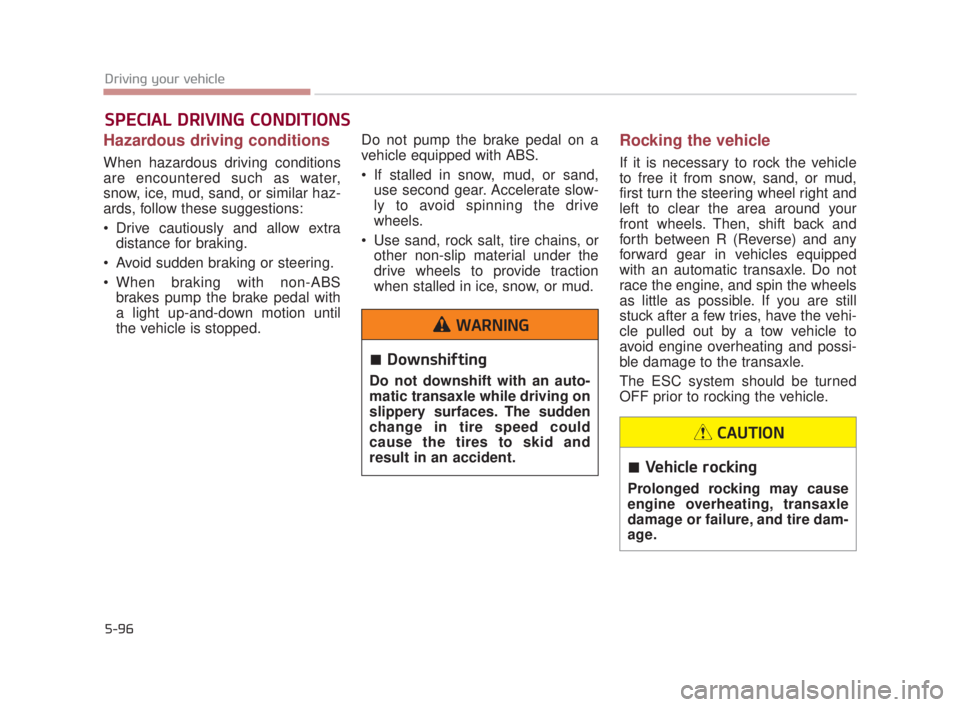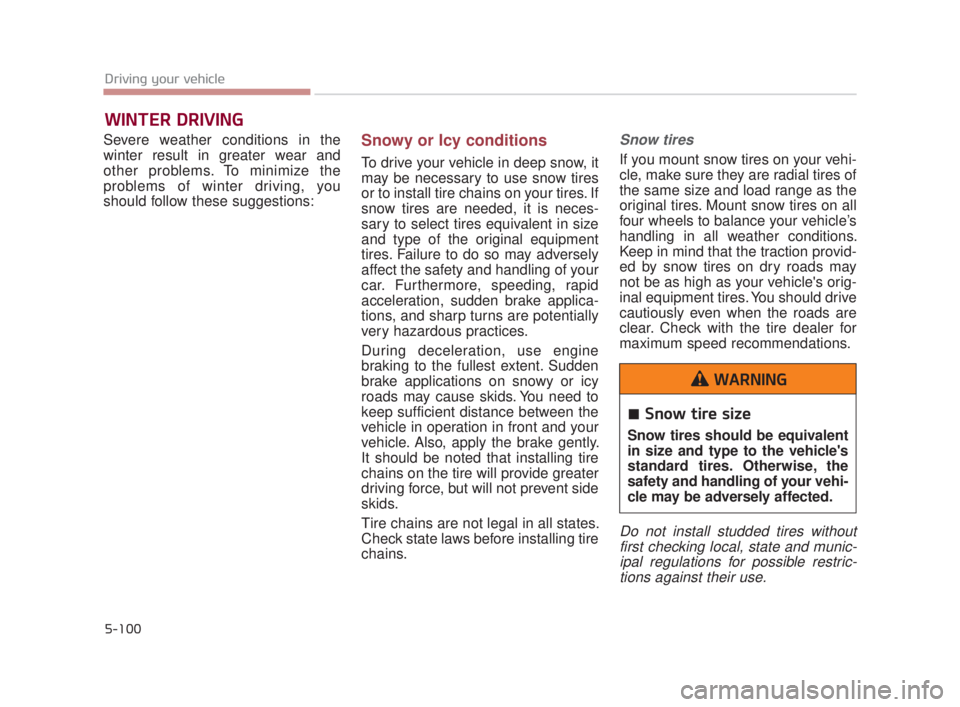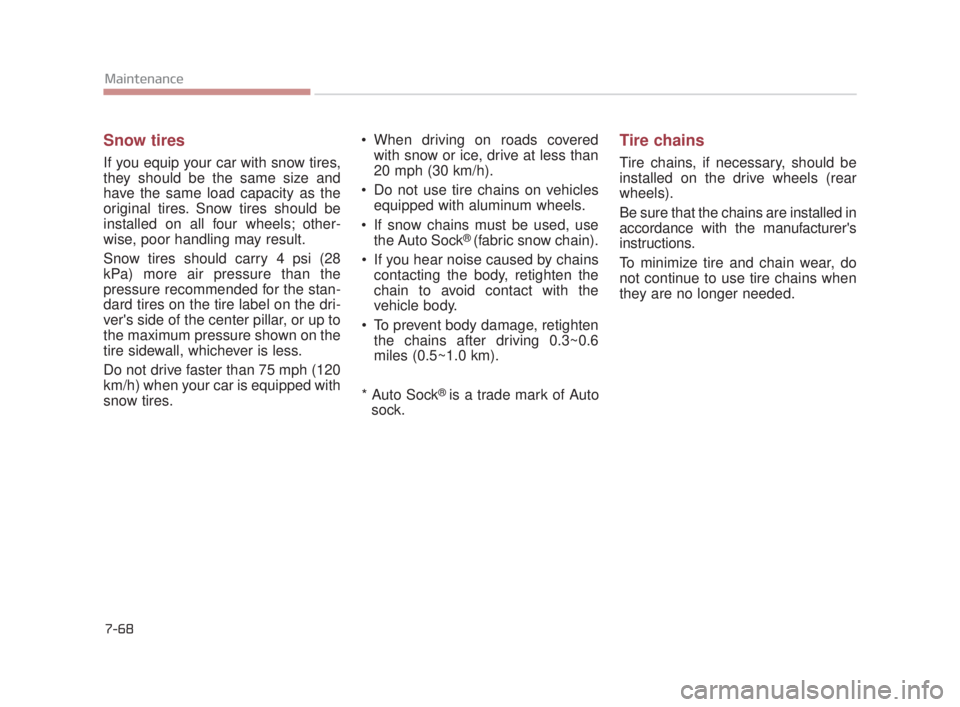2018 KIA K900 snow chains
[x] Cancel search: snow chainsPage 201 of 544

Features of your vehicle
4-120
Non-operational conditions of
parking assist system
Parking assist system may notoperate normally when:
1.Moisture is frozen to the sensor. (It will operate normally when mois-
ture melts.)
2.Sensor is covered with foreign mat- ter, such as snow or water, or the
sensor cover is blocked. (It will
operate normally when the materi-
al is removed or the sensor is no
longer blocked.)
3.Sensor is stained with foreign mat- ter such as snow or water.
(Sensing range will return to nor-
mal when removed.)
4.The parking assist button is off.
There is a possibility of parking assist system malfunction when:
1.Driving on uneven road surfaces such as unpaved roads, gravel,
bumps, or gradient.
2.Objects generating excessive noise such as vehicle horns, loud motor-
cycle engines, or truck air brakes
can interfere with the sensor.
3.Heavy rain or water spray.
4.Wireless transmitters or mobile phones present near the sensor.
5.Sensor is covered with snow.
Detecting range may decrease when:
1.Outside air temperature is extremely hot or cold.
2.Undetectable objects smaller than 39 in (1 m) and narrower than 5.5
in (14 cm) in diameter.
The following objects may not be
recognized by the sensor:
1.Sharp or slim objects such as ropes, chains or small poles.
2.Objects, which tend to absorb sen- sor frequency such as clothes,
spongy material or snow.
KH USA 4:2018 4/18/2017 6:00 PM Page 120
Page 306 of 544
![KIA K900 2018 Owners Manual Driving your vehicle
5
5-41
When you press the [AUTO HOLD]
switch, if the driver door, engine
hood and trunk are not closed or the
driver seat belt is not fastened, the
notice will illuminate on the L KIA K900 2018 Owners Manual Driving your vehicle
5
5-41
When you press the [AUTO HOLD]
switch, if the driver door, engine
hood and trunk are not closed or the
driver seat belt is not fastened, the
notice will illuminate on the L](/manual-img/2/57959/w960_57959-305.png)
Driving your vehicle
5
5-41
When you press the [AUTO HOLD]
switch, if the driver door, engine
hood and trunk are not closed or the
driver seat belt is not fastened, the
notice will illuminate on the LCD dis-
play. Also warning chime sounds
once. In that time, press the [AUTO
HOLD] button after closing the driver
door, engine hood and trunk and fas-
tening the seat belt.
Anti-lock brake system (ABS)
ABS (or ESC) will not prevent acci-
dents due to improper or dangerous
driving maneuvers. Even though
vehicle control is improved during
emergency braking, always maintain
a safe distance between you and
objects ahead. Vehicle speeds
should always be reduced during
extreme road conditions.
The vehicle should be driven at
reduced speeds in the following cir-
cumstances:
When driving on rough, gravel orsnow-covered roads
When driving with tire chains installed
When driving on roads where the road surface is pitted or has differ-
ent surface heights.
Driving in these conditions increases
the stopping distance for your vehi-
cle. The ABS continuously senses the
speed of the wheels. If the wheels
are going to lock, the ABS system
repeatedly modulates the hydraulic
brake pressure to the wheels.
When you apply your brakes under
conditions which may lock the
wheels, you may hear a “tik-tik’’
sound from the brakes, or feel a cor-
responding sensation in the brake
pedal. This is normal and it means
your ABS is active.
In order to obtain the maximum ben-
efit from your ABS in an emergency
situation, do not attempt to modulate
your brake pressure and do not try to
pump your brakes. Press your brake
pedal as hard as possible or as hard
as the situation allows the ABS to
control the force being delivered to
the brakes.
OKH053046N
■Type A■Type B
KH USA 5:2018 4/12/2017 9:59 AM Page 41
Page 361 of 544

5-96
Driving your vehicle
Hazardous driving conditions
When hazardous driving conditions
are encountered such as water,
snow, ice, mud, sand, or similar haz-
ards, follow these suggestions:
Drive cautiously and allow extradistance for braking.
Avoid sudden braking or steering.
When braking with non-ABS brakes pump the brake pedal with
a light up-and-down motion until
the vehicle is stopped. Do not pump the brake pedal on a
vehicle equipped with ABS.
If stalled in snow, mud, or sand,
use second gear. Accelerate slow-
ly to avoid spinning the drive
wheels.
Use sand, rock salt, tire chains, or other non-slip material under the
drive wheels to provide traction
when stalled in ice, snow, or mud.
Rocking the vehicle
If it is necessary to rock the vehicle
to free it from snow, sand, or mud,
first turn the steering wheel right and
left to clear the area around your
front wheels. Then, shift back and
forth between R (Reverse) and any
forward gear in vehicles equipped
with an automatic transaxle. Do not
race the engine, and spin the wheels
as little as possible. If you are still
stuck after a few tries, have the vehi-
cle pulled out by a tow vehicle to
avoid engine overheating and possi-
ble damage to the transaxle.
The ESC system should be turned
OFF prior to rocking the vehicle.
SPECIAL DRIVING CONDITIONS
Downshifting
Do not downshift with an auto-
matic transaxle while driving on
slippery surfaces. The sudden
change in tire speed could
cause the tires to skid and
result in an accident.
WARNING
Vehicle rocking
Prolonged rocking may cause
engine overheating, transaxle
damage or failure, and tire dam-
age.
CAUTION
KH USA 5:2018 4/12/2017 10:02 AM Page 96
Page 365 of 544

5-100
Driving your vehicle
Severe weather conditions in the
winter result in greater wear and
other problems. To minimize the
problems of winter driving, you
should follow these suggestions:Snowy or Icy conditions
To drive your vehicle in deep snow, it
may be necessary to use snow tires
or to install tire chains on your tires. If
snow tires are needed, it is neces-
sary to select tires equivalent in size
and type of the original equipment
tires. Failure to do so may adversely
affect the safety and handling of your
car. Furthermore, speeding, rapid
acceleration, sudden brake applica-
tions, and sharp turns are potentially
very hazardous practices.
During deceleration, use engine
braking to the fullest extent. Sudden
brake applications on snowy or icy
roads may cause skids. You need to
keep sufficient distance between the
vehicle in operation in front and your
vehicle. Also, apply the brake gently.
It should be noted that installing tire
chains on the tire will provide greater
driving force, but will not prevent side
skids.
Tire chains are not legal in all states.
Check state laws before installing tire
chains.
Snow tires
If you mount snow tires on your vehi-
cle, make sure they are radial tires of
the same size and load range as the
original tires. Mount snow tires on all
four wheels to balance your vehicle’s
handling in all weather conditions.
Keep in mind that the traction provid-
ed by snow tires on dry roads may
not be as high as your vehicle's orig-
inal equipment tires. You should drive
cautiously even when the roads are
clear. Check with the tire dealer for
maximum speed recommendations.
Do not install studded tires withoutfirst checking local, state and munic-ipal regulations for possible restric-tions against their use.
WINTER DRIVING
Snow tire size
Snow tires should be equivalent
in size and type to the vehicle's
standard tires. Otherwise, the
safety and handling of your vehi-
cle may be adversely affected.
WARNING
KH USA 5:2018 4/12/2017 10:02 AM Page 100
Page 366 of 544

Driving your vehicle
5
5-101
Tire chains
Since the sidewalls of radial tires are
thinner, they can be damaged by
mounting some types of snow chains
on them. Therefore, the use of snow
tires is recommended instead of
snow chains. Do not mount tire
chains on vehicles equipped with
aluminum wheels; snow chains may
cause damage to the wheels. If snow
chains must be used, use the
AutoSock
®(fabric snow chain).
Damage to your vehicle caused by
improper snow chain use is not cov-
ered by your vehicle manufacturers
warranty.
Install the AutoSock
®(fabric snow
chain) only on the rear tires.
✽ NOTICE
Always check the AutoSock®(fabric
snow chain) installation for proper
mounting after driving approximate-
ly 0.3 to 0.6 miles (0.5 to 1 km) to
ensure safe mounting. Retighten or
remount the AutoSock
®(fabric snow
chain) if they are loose.
❈ AutoSock®is a Registered trade-
mark of AutoSock®. Chain installation
When installing the AutoSock
®(fab-
ric snow chain), follow the manufac-
turer's instructions and mount them
as tightly as you can. Drive slowly
with the AutoSock
®(fabric snow
chain) installed. If you hear the
AutoSock
®(fabric snow chain) con-
tacting the body or chassis, stop and
tighten them. If they still make con-
tact, slow down until it stops.
Remove the AutoSock
®(fabric snow
chain) as soon as you begin driving
on cleared roads.
When mounting the AutoSock
®(fab-
ric snow chain), park the vehicle on
level ground away from traffic. Turn
on the vehicle Hazard Warning flash-
ers and place a triangular emer-
gency warning device behind the
vehicle if available. Always place the
vehicle in P (Park), apply the parking
brake and turn off the engine before
installing the AutoSock
®(fabric snow
chain).
OKH055098N
Make sure the AutoSock®(fabric
snow chain) are the correct size
and type for your tires. Incorrect
snow chains can cause damage
to the vehicle body and suspen-
sion and may not be covered by
your vehicle manufacturer war-
ranty.
CAUTION
KH USA 5:2018 4/12/2017 10:02 AM Page 101
Page 389 of 544

6-14
What to do in an emergency
The tire pressure may varydepending on various factors
including the temperature condi-
tions of parking area, driving condi-
tions and ambient temperature,
altitude above sea level.
The tire pressure displayed on the instrument panel may be different
from the tire pressure measured by
a tire pressure gauge.TPMS (Tire Pressure
Monitoring System)
malfunction indicator
The TPMS malfunction indicator will
illuminate after it blinks for approxi-
mately one minute when there is a
problem with the Tire Pressure
Monitoring System.
Have the system checked by an
authorized K900 Kia dealer as soon
as possible to determine the cause
of the problem.
✽ NOTICE
If there is a malfunction with the
TPMS, the low tire pressure position
telltale will not be displayed even
though the vehicle has an under-
inflated tire.
The TPMS malfunction indicator
may blink for approximately 1
minute and then remain continu-
ously illuminated if the vehicle is
moving around electric power sup-
ply cables or radio transmitter such
as at police stations, government
and public offices, broadcasting
stations, military installations, air-
ports, or transmitting towers, etc.
This can interfere with normal
operation of the Tire Pressure
Monitoring System (TPMS).
The TPMS malfunction indicator may blink for approximately 1
minute and then remain continu-
ously illuminated if the snow
chains are used or some separate
electronic devices such as note-
book computer, mobile charger,
remote starter or navigation etc.,
are used in the vehicle. This can
interfere with normal operation of
the Tire Pressure Monitoring
System (TPMS).
Low pressure damage
Significantly low tire pressure
makes the vehicle unstable and
can contribute to loss of vehicle
control and increased braking
distances.
Continued driving on low pres-
sure tires can cause the tires to
overheat and fail.
WARNING
KH USA 6:2018 4/12/2017 10:21 AM Page 14
Page 476 of 544

7-68
Maintenance
Snow tires
If you equip your car with snow tires,
they should be the same size and
have the same load capacity as the
original tires. Snow tires should be
installed on all four wheels; other-
wise, poor handling may result.
Snow tires should carry 4 psi (28
kPa) more air pressure than the
pressure recommended for the stan-
dard tires on the tire label on the dri-
ver's side of the center pillar, or up to
the maximum pressure shown on the
tire sidewall, whichever is less.
Do not drive faster than 75 mph (120
km/h) when your car is equipped with
snow tires. When driving on roads covered
with snow or ice, drive at less than
20 mph (30 km/h).
Do not use tire chains on vehicles equipped with aluminum wheels.
If snow chains must be used, use the Auto Sock
® (fabric snow chain).
If you hear noise caused by chains contacting the body, retighten the
chain to avoid contact with the
vehicle body.
To prevent body damage, retighten the chains after driving 0.3~0.6
miles (0.5~1.0 km).
* Auto Sock
® is a trade mark of Auto
sock.
Tire chains
Tire chains, if necessary, should be
installed on the drive wheels (rear
wheels).
Be sure that the chains are installed in
accordance with the manufacturer's
instructions.
To minimize tire and chain wear, do
not continue to use tire chains when
they are no longer needed.
KH USA 7:2018 4/14/2017 6:39 PM Page 68
Page 543 of 544

USB charger ................................................................4-17\
9
User Settings Mode .......................................................4-78
Vanity mirror lamp.......................................................4-142
Vehicle break-in process .................................................1-5
Vehicle data collection and event data recorders.............1-6
Vehicle identification number (VIN) ...............................8-9
Vehicle load limit .........................................................5-105Certification label ....................................................5-108
Tire and loading information label..........................5-105
Vehicle weight .............................................................5-110
Warning light ...............................................................4-100
Warning Messages .........................................................4-85
Washer fluid ...................................................................7-40
Welcome system ..........................................................4-128 Headlight .................................................................4-128
Interior light ............................................................4-128
Puddle lamp.............................................................4-128
Wheel alignment and tire balance .................................7-57
Wheel replacement ........................................................7-59
Windows ........................................................................\
4-31 Power window lock button........................................4-34 Windshield defrosting and defogging..........................4-158
Windshield washers .....................................................4-138
Windshield wipers .......................................................4-136
Winter driving ..............................................................5-100
Snow tires ................................................................5-100
Tire chains ...............................................................5-101
Wiper blades ..................................................................7-46
Wipers and washers .....................................................4-136 Windshield washers.................................................4-138
Windshield wipers ...................................................4-136
I-12
Index
U
V
W
KH USA Index:2018 4/18/2017 10:39 AM Page 12